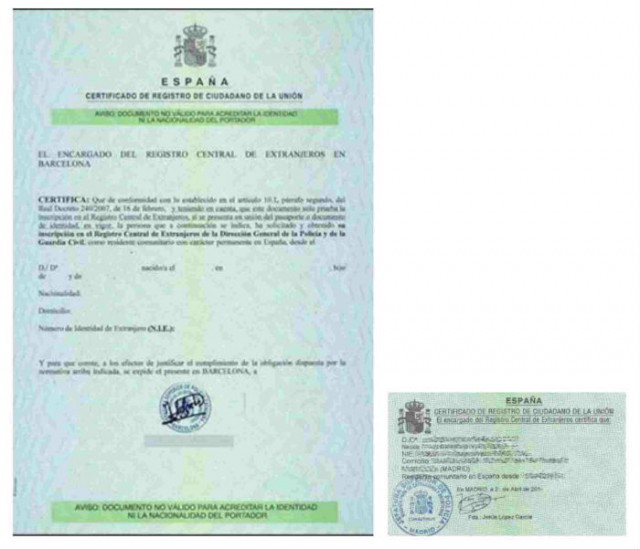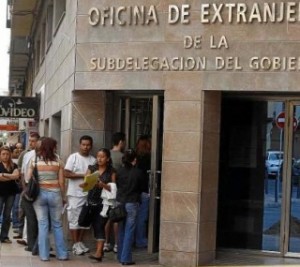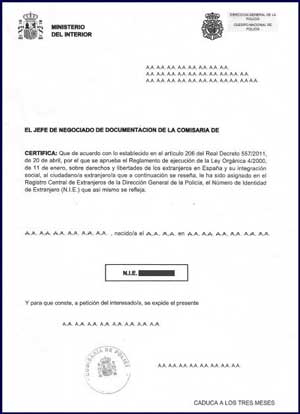Everything you need to know about Spain's NIE number

Anyone who has spent any time living in Spain will be aware how essential the NIE is to get anything done.
What is a NIE number?
The NIE stands for Número de Identificación de Extranjero - identification number for foreigners and is issued to those who live, work, or invest here and who do not have the status of Spanish citizens.
The official website of Spain’s Interior Ministry describes the NIE number as follows:
Foreigners that, for their economic, social or professional interests, become associated with Spain, will be given, for identification purposes, a personal exclusive number unique to the individuals.
Basically, it is an identification number assigned FOR LEGAL PURPOSES to foreigners who have dealings in Spain. It is the alternative to the DNI - Documento Nacional de Identidad -(National Identity Document) assigned to each Spanish citizen.
The NIE is not a fiscal residency identification; you can have a NIE and be fiscal resident in another country.
What does an NIE look like?
The NIE consists of an 'X' or 'Y' followed by 7 or 8 digits then another letter.
Who needs a NIE number?
The simple answer is everyone who isn't Spanish and wants to do business, live, work or invest in Spain.
The NIE number is needed in order to file taxes, buy property, establish a business, open a bank account, and for almost all other forms you fill out. When forming a company, everyone who will be directors and shareholders of the company will need a NIE, as a result of the Fraud Prevention Act which came into force on February 2005. Getting a NIE is the first step in forming a company.
Don’t confuse NIE with Resident’s certificate

Either of the two documents above - which include the NIE - are proof that you are registered as a resident in Spain.
Many people (those from within EU) may have skipped the process of applying separately for a NIE and gone straight for the Certificado de Registro de Ciudadano de la Unión. This is a green piece of A4 paper or credit card size green paper that will have your NIE number on it.
But just to be clear, having a NIE .(Número de Identificación de Extranjero) is not a guarantee that you are registered as a resident. So if you need a Certificado read about how to do that HERE.
READ MORE:This is the ONE thing Brits in Spain need to do ahead of Brexit
How to get a NIE
There are two places to apply for a NIE either at a National Police station or Oficina de Extranjeros (Foreigners office) in Spain or at a Spanish embassy located outside Spain.
Not every office of the Policia Nacional is authorized to issue NIEs but you can find a list of those that are on the Policia Nacional website HERE
The NIE must be requested in person, or through a legal authorised person – (a gestor with a power of attorney).
This is Spain so there are no hard and fast rules. How to apply for a NIE depends on the process at that particular National Police office. There may be a queue system, you may have to make a private appointment (cita previa) or make an appointment in person at the office.
Your best bet is to go to the designated police station and ask.

BUT in most cities you will be required to get a Cita Previa.
-
Go to the National Police website and request one: HERE
-
Choose your city and then choose: Policia-Asignación de NIE from the drop down menu.
Securing an appointment can be a challenge. The chances are you will be told that all the available appointments for the coming days have been filled and to check back later. Repeat the request several dozen times over the course of a week and you might be luckily enough to snag yourself a slot.
INSIDER TIP: Many of the appointments are block booked by gestors so if you are willing to pay, you can bypass the process and employ someone to do it for you. You do not need to be there in person but will need to give the gestor power of attorney.
The paperwork

Photo: Billiondigital/Depositphotos
-
If you have come for a cita previa then you need either a print out of the appointment date and time or show a screenshot on your mobile to get through the door!
-
You will need the EX-15 form filled out in Spanish. DOWNLOAD IT HERE And a photocopy
-
You will need to show your original passport and hand over a photocopy of it (ALL PAGES)
-
Form 790 This form needs to be filled out online and then printed out and taken to a bank (any bank) where you will pay the fee (€9.64 in January 2019) and it will be stamped. DOWNLOAD IT HERE
-
You will need to provide an address
Good to know
The NIE is usually printed off and given to you on the spot
Once assigned, you will keep that number forever.

Your NIE certificate will look something like this.
MORE INFORMATION:
-
Spanish interior ministry website HERE
-
List of Policia Nacional and Foreigner's Offices that can process NIE, HERE
-
Ask an expert: David Ruiz at Torrevieja Translations has written books about this subject and offers a service to guide you through the process.
If you have been through the process, then let us now how the experience was and whether you can offer any tips to those planning on doing it soon. Leave a comment below or email [email protected]
READ ALSO: How to exchanging your British driving licence for a Spanish one
Comments
See Also
What is a NIE number?
The NIE stands for Número de Identificación de Extranjero - identification number for foreigners and is issued to those who live, work, or invest here and who do not have the status of Spanish citizens.
The official website of Spain’s Interior Ministry describes the NIE number as follows:
Foreigners that, for their economic, social or professional interests, become associated with Spain, will be given, for identification purposes, a personal exclusive number unique to the individuals.
Basically, it is an identification number assigned FOR LEGAL PURPOSES to foreigners who have dealings in Spain. It is the alternative to the DNI - Documento Nacional de Identidad -(National Identity Document) assigned to each Spanish citizen.
The NIE is not a fiscal residency identification; you can have a NIE and be fiscal resident in another country.
What does an NIE look like?
The NIE consists of an 'X' or 'Y' followed by 7 or 8 digits then another letter.
Who needs a NIE number?
The simple answer is everyone who isn't Spanish and wants to do business, live, work or invest in Spain.
The NIE number is needed in order to file taxes, buy property, establish a business, open a bank account, and for almost all other forms you fill out. When forming a company, everyone who will be directors and shareholders of the company will need a NIE, as a result of the Fraud Prevention Act which came into force on February 2005. Getting a NIE is the first step in forming a company.
Don’t confuse NIE with Resident’s certificate

Either of the two documents above - which include the NIE - are proof that you are registered as a resident in Spain.
Many people (those from within EU) may have skipped the process of applying separately for a NIE and gone straight for the Certificado de Registro de Ciudadano de la Unión. This is a green piece of A4 paper or credit card size green paper that will have your NIE number on it.
But just to be clear, having a NIE .(Número de Identificación de Extranjero) is not a guarantee that you are registered as a resident. So if you need a Certificado read about how to do that HERE.
READ MORE:This is the ONE thing Brits in Spain need to do ahead of Brexit
How to get a NIE
There are two places to apply for a NIE either at a National Police station or Oficina de Extranjeros (Foreigners office) in Spain or at a Spanish embassy located outside Spain.
Not every office of the Policia Nacional is authorized to issue NIEs but you can find a list of those that are on the Policia Nacional website HERE
The NIE must be requested in person, or through a legal authorised person – (a gestor with a power of attorney).
This is Spain so there are no hard and fast rules. How to apply for a NIE depends on the process at that particular National Police office. There may be a queue system, you may have to make a private appointment (cita previa) or make an appointment in person at the office.
Your best bet is to go to the designated police station and ask.

BUT in most cities you will be required to get a Cita Previa.
- Go to the National Police website and request one: HERE
- Choose your city and then choose: Policia-Asignación de NIE from the drop down menu.
Securing an appointment can be a challenge. The chances are you will be told that all the available appointments for the coming days have been filled and to check back later. Repeat the request several dozen times over the course of a week and you might be luckily enough to snag yourself a slot.
INSIDER TIP: Many of the appointments are block booked by gestors so if you are willing to pay, you can bypass the process and employ someone to do it for you. You do not need to be there in person but will need to give the gestor power of attorney.
The paperwork

Photo: Billiondigital/Depositphotos
- If you have come for a cita previa then you need either a print out of the appointment date and time or show a screenshot on your mobile to get through the door!
- You will need the EX-15 form filled out in Spanish. DOWNLOAD IT HERE And a photocopy
- You will need to show your original passport and hand over a photocopy of it (ALL PAGES)
- Form 790 This form needs to be filled out online and then printed out and taken to a bank (any bank) where you will pay the fee (€9.64 in January 2019) and it will be stamped. DOWNLOAD IT HERE
- You will need to provide an address
Good to know
The NIE is usually printed off and given to you on the spot
Once assigned, you will keep that number forever.

Your NIE certificate will look something like this.
MORE INFORMATION:
- Spanish interior ministry website HERE
- List of Policia Nacional and Foreigner's Offices that can process NIE, HERE
- Ask an expert: David Ruiz at Torrevieja Translations has written books about this subject and offers a service to guide you through the process.
If you have been through the process, then let us now how the experience was and whether you can offer any tips to those planning on doing it soon. Leave a comment below or email [email protected]
READ ALSO: How to exchanging your British driving licence for a Spanish one
Join the conversation in our comments section below. Share your own views and experience and if you have a question or suggestion for our journalists then email us at [email protected].
Please keep comments civil, constructive and on topic – and make sure to read our terms of use before getting involved.
Please log in here to leave a comment.